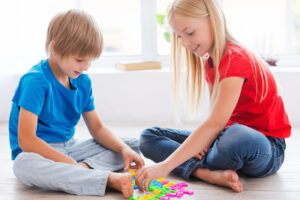Below is a list of calming/alerting strategies to assist with self-regulation:
- Breathing exercises (figure eight breathing, pinwheel, bubbles, blow a feather or cotton ball across the room or table with mouth/straw).
- Physical exercise (wall pushes, chair push-ups, going for a walk, running, jumping, climbing, yoga).
- Take a break or walk away from the situation.
- Finger pulls, give self a hug, squeeze a pillow or stuffed animal, joint compression.
- Talk to someone.
- Asking for help.
- Draw a picture, journal, draw with chalk, play with sand, play with shaving cream, doe mazes, dot to dot activities.
- Read a book.
- Name things alphabetically to divert attention (animals, foods, places).
- Weighted blanket or lap pad, weighted stuffed animal.
- Pet/play with animals.
- Chew gum or another crunchy snack.
- Fidgets.
- Watch TV or a movie.
- Whisper the alphabet forward/backward, count to 10, whisper favorite song.
Children often have a difficult time being able to self-regulate after becoming upset, too excited, or angry. If you have questions or concerns, please do not hesitate to reach out.
Skills to target with this activity are:
- Bilateral motor coordination
- Color identification and matching
- Tactile Sensory
- Hand-eye coordination
- Improves logic and reasoning
- Fine motor skills


